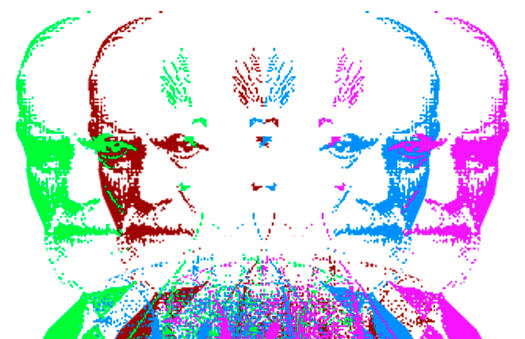New meta-analytic data published in The American Journal of Psychiatry finds that psychodynamic therapy is just as efficacious as other empirically supported treatments, including cognitive behavioral therapy (CBT).
“For the first time the equivalence of psychodynamic therapy to treatments established in efficacy was formally tested.”

Psychodynamic psychotherapy comes from traditional psychoanalytic approaches, the basis of which were established by Sigmund Freud. The modern-day approach centers around fostering a supportive client-therapist relationship, focusing on emotion and emotion expression, identifying client patterns and themes, discussing past experiences, examining fantasies and dreams, and focusing on interpersonal issues.
While practice guidelines regard CBT and other forms of therapy as empirically supported toward the treatment of mental health symptoms, the data on the efficacy of psychodynamic therapy has been mixed. However, the approach remains popular among a large proportion of therapists who endorse psychodynamic psychotherapy as their primary orientation.
Evidence suggests that researcher allegiance and conflicts of interest within psychotherapy research may have a pronounced impact on reporting and practice guidelines (see MIA report). The authors of this study sought to control bias by developing a cross-modal team of researchers representing both CBT and psychodynamic approaches. In addition to this, Steinert and a team of researchers assessed each study for allegiance conflicts using a scale developed by co-author, Munder. Interrater agreement was reportedly excellent (ICC = 0.83) and disagreements were resolved by consensus.
Given the number of practitioners in the field who align with psychodynamic approaches, examining the efficacy of psychodynamic psychotherapy is “of high relevance to patients, therapists, and the health care system in general,” point out the authors.
In this meta-analysis, 23 randomized control trials covering data on 2,751 participants were examined. Twenty-one of these trials featured the comparison of psychodynamic therapy and a method of CBT. The remaining 2 studies compared psychodynamic therapy with anti-depressant drugs (SSRIs) as a treatment for depression. Participants in these studies were adults presenting with symptoms consistent to DSM or ICD-10 diagnoses of depression, anxiety, eating disorders, personality disorders, substance dependence, and posttraumatic stress disorder (PTSD).
The consolidated findings of these carefully selected studies revealed that psychodynamic psychotherapy is equivalent in outcomes to CBT and other treatments established in efficacy. Outcomes were defined as target symptoms with respect to the “disorder” (e.g. depressive symptoms in depressive disorders). Secondary outcomes, including general psychiatric symptoms and psychosocial functioning, as well as posttreatment and follow-up assessments, were also considered.
What sets this data apart from previous findings are the rigorous methods employed including “adversarial collaboration” to account for researcher allegiance, the assessment of study quality, and the systematic investigation of equivalence. The authors write:
“Because we used high methodological standards (e.g., controlling for researcher allegiance, applying the logic of equivalence testing, using one of the smallest margins ever suggested as compatible with equivalence, and using treatments established in efficacy as comparators), the results of this meta-analysis can be expected to be robust.”
Not enough studies featuring pharmacotherapy interventions were included in this meta-analysis to confidently assess differences between psychodynamic psychotherapy and anti-depressants for the treatment of depressive disorders. As with all meta-analyses, this study is limited by the nature of studies included.
The authors conclude by noting that while establishing efficacy is a step forward, no current intervention can claim to be “the panacea” in treating mental health symptoms, especially given that response and remission rates across client presenting problems remains low. Future research, they note, ought to focus on determining which approaches are best suited to the specific needs of clients, and the implications of therapist effects on outcomes suggesting the need to enhance therapist training.
****
Steinert, C., Munder, T., Rabung, S., Hoyer, J., & Leichsenring, F. (2017). Psychodynamic Therapy: As Efficacious as Other Empirically Supported Treatments? A Meta-Analysis Testing Equivalence of Outcomes. American Journal of Psychiatry. (Abstract)















I am disappointed to see this study highlighted here with this sensationalistic headline. A cursory reading of this article reveals a number of problems, and MIA staff should be aware that the American Journal of Psychiatry is known to be a biased source of information about both the biomedical model and psychodynamic therapy. The APA’s guild interests cover both domains.
Potential problems I’ve noticed in this post and/or the article include: (1) relatively few or no studies of psychodynamic therapy vs. CBT have been conducted for most MH problems, yet they suggest both approaches are equally effective for all issues, (2) they ignore the many psychological problems for which CBT has proven efficacy and psychodynamic therapy has little or none, (3) they ignore the patently pseudoscientific nature of psychodynamic theories (e.g., assuming in the absence of any evidence present-day problems are caused by repressed childhood unconscious conflicts), (4) many of the studies in this meta-analysis compare psychodynamic therapy to suboptimal forms of CBT, typically in studies conducted by psychodynamic proponents who did not collaborate with CBT researchers who could help ensure a proper test vs. the best available CBT intervention, and (5) because psychodynamic therapy takes so long, the usual manner in which researchers conduct comparative trials is to make CBT last much longer than necessary in order to equate the approaches in number of sessions. Case in point, standard CBT for panic disorder is generally conducted in 12-session trials, though studies show it works just as well in 5 sessions. But in the Milrod et al. 2016 study, CBT was stretched to twice its normal length (19-24) sessions just so it could be compared to psychodynamic therapy. No CBT scientist/clinician I know takes this study seriously or would be caught dead delivering CBT this way, yet psychodynamic folks use it as evidence their approach is just as good.
Report comment
Thanks to Brett Deacon for responding appropriately to this unfortunate post / link – your time, wisdom and academic rigor is greatly appreciated. Warmly Rob Purssey (ACT therapist and psychiatrist)
Report comment
A quick google search and I find two articles on this, one saying CBT is no better than other forms of therapy, the other saying that it is for anxiety and depression and possible other forms of distress.
You pays your money and you takes your choice.
Unless you have the skills and time to in detail analyse the two articles and write up fair critiques of either.
Here are the links
http://www.sciencedirect.com/science/article/pii/S027273581300007X – says no difference
https://www.ncbi.nlm.nih.gov/pubmed/20547435 – says CBT probably better, at least for anxiety and depression.
Personally I found not being in dire poverty and being part of a supportive community helped more than anything.
Report comment
Psychodynamical therapy has extreme amount of clinical information about schizophrenia. Basically, psychodynamists worked with schizophrenics extremely closely and gave pretty meaningful albeit noisy explanation of the illness.
I can’t let go of feeling how much things clicks when you read old psychodynamic stuff. I’m now going through ‘Schizoid Phenomena, Object-relations and the Self’, and sometimes you need to skip all the libido interpretations but it gives clear easy to grasp framework on what caused psychosis what is the structure of psychosis and what cases relapse.
Was incredibly useful read for me. I believe Matt Stevenson also mentioned a lot of psychodynamical works in his article on schizophrenia-recovery. Also many of isps.org books are psychodynamical in nature.
So I would recommend at least take a look if you are affected by psychosis. Pretty interesting read. When you affected by psychosis you take ‘whatever works’ approach.
Report comment
That’s odd. I thought that delusions were an attempt to find meaning in the perceptual changes that were the indicator of a “schizophrenic” state; e.g., that delusions about being watched came from the sensations of being watched or spied upon, particularly when combined with the “audios”, particularly of voices talking about or to you. In any case, the changes came first, followed by the ideation. This is the reason the ideas are so persistent- sufferers are asked to deny the “real” evidence of their own senses.
Report comment
After psychotherapy it’s clicked and I realised that there never were ‘random awful sudden changes’. The whole psychotic experience was pretty understandable and explainable.
I could only recommend the book ‘Schizoid phrenomena, object-relationships and self’ which is basically the psychoanalytical masterpiece if you’re interested.
Bollos work ‘The enigma of schizophrenia’ is also good
Report comment
CBT / Psychodynamic Psychotherapy for “schizophrenia” – but how could anyone talk to a mad person? Obviously the “person” wouldn’t be all that mad If they could communicate and benefit from Psychotherapy.
I’ve used “CBT” and “Mindfulness” and “Buddhist Meditation” and they provided me with effective long term solutions.
(My situation at the time was fairly “homogenous”. I’d come off disabling and suicidal neuroleptics and I was having a lot of difficulty keeping my head together).
Report comment
You aren’t alone, Fiachra. Freud believed psychoanalysis was definitely a no-no for treating psychotic individuals.
Report comment
The attractiveness of the medical model is it’s simplicity and as such it claims that we can have treatment A applied to condition B and we will have outcome C. When psychology operates in such a fashion the result is so-called empirically supported or evidence based treatments like CBT. The problem with this is we know that the most important and telling “active ingredient’ is not the approach or the technique, but the therapeutic relationship, the conditions to be targeted have a dubious existence to start off with so what is in fact being treated and most people who seek therapy don’t just want “symptom relief” as an outcome, but able to make changes, live with a purpose, feel in control again, understand themselves better, have satisfying relationships, etc.
I can only hope that psychology will one day feel that they have a right to exist as an independent science and discipline and that they don’t have to copy and pander to the pseudoscience of psychiatry
Report comment
Very well said. The client’s objectives have to be the therapist’s objectives – otherwise, it’s not therapy, it’s social control.
Report comment
Gerard,
I think Neuroleptic treated “Mental Illness” eventually does become homogenous – the consumer becomes dependent on the drugs and drug withdrawal generally leads to “High Anxiety”.
Report comment
Yep,
What I had was a type of withdrawal syndrome – and “CBT” gave me the skills to deal with this.
Report comment
The research results of psychodynamic therapy equaling CBT is because of the dodo bird effect. Read: “The Legacy of Saul Rosenzweig: The Profundity of the Dodo Bird” by Barry Duncan. It’s available here: http://www.personal.kent.edu/~dfresco/CRM_Readings/Duncan_dodo_2002.pdf.
Duncan’s article explores the history of what he calls “common factors” in psychotherapy, a reconceptualizing of what Lambert identified in 1992 as “therapeutic factors.” The idea that common factors to different psychotherapies could account for therapeutic change dates back to Saul Rosenzweig’s 1936 paper. Quoted from the Duncan article:
“Lambert (1992) identified four therapeutic factors (extratherapeutic, common factors, expectancy or placebo, and techniques) as the principal elements accounting for improvement in psychotherapy. Inspired by Lambert’s proposal, Miller et al. (1997) expanded the use of the term common factors from its traditional meaning of nonspecific or relational factors to include four specific factors: client, relationship, placebo, and technique.”
“The Heart and Soul of Change,” by Mark Hubble, Barry Duncan and Scott Miller (now in its 2nd edition) showed how these common factors demonstrate that improvement during psychotherapy can be attributed as follows: client (40%), relationship (30%), placebo (15%), and technique (15%). The relationship factor is seen as fifty-fifty client and therapist. So improvement in psychotherapy from this perspective is 70% due to the client and 30% due to a therapist and technique.
Also try “The Dodo Bird Effect” or “Another Brick in the Wall” on my website: http://faith-seeking-understanding.org/
Report comment
Thanks, that is very educational and comports very well with my own observations. Techniques are like tools that one can use or options that one has available, but without client motivation and a good relationship, no particular technique is of the slightest use. Given that placebo effect is just as strong as technique, I think we can dispense with spending a lot of time talking about which approach is “best” and recall that all good therapy starts with good human relationships.
Report comment
Duncan and his coauthors identified the the premise behind evidence-based evaluations of various psychotherapies as coming from a medical model approach to assessing psychotherapy: “diagnosis plus prescriptive treatment equals symptom amelioration.”
Report comment
The dodo bird effect has been refuted many, many times.
See this article here as just one example: http://www.srmhp.org/0101/psychotherapy-equivalence.html
Also see Jerry Coyne’s Blog. Sure he will have to say something about this study too. http://blogs.plos.org/mindthebrain/2014/03/24/bambi-meets-godzilla-independent-evaluation-superiority-long-term-psychodynamic-therapy/
Report comment
I found this post useful and positive, promoting psychodynamic and cognitive interpersonal therapies as alternatives to (coercive) psychiatric drug treatments. In particular I’d like to see a range of therapies offered to people experiencing psychosis, flexible, skilled therapists who are able to empathise with the person and most of all listen to what they are saying.
I’ve had enough of coercive drugging by psychiatric professionals, on myself and other family members, when experiencing altered mind states due to life trauma. I’m planning research into safe haven crisis houses in the UK and abroad, to evidence good practice and to influence development of safe houses in Scotland, avoiding coercive psychiatric inpatient treatment.
Report comment